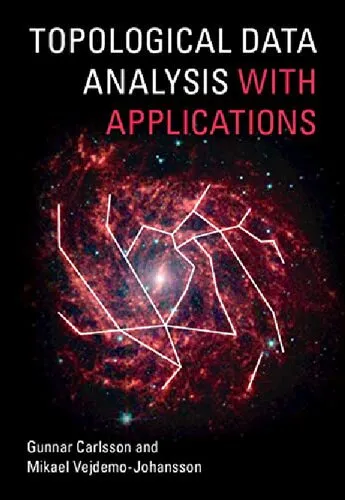Topological Data Analysis with Applications
4.2
بر اساس نظر کاربران

شما میتونید سوالاتتون در باره کتاب رو از هوش مصنوعیش بعد از ورود بپرسید
هر دانلود یا پرسش از هوش مصنوعی 2 امتیاز لازم دارد، برای بدست آوردن امتیاز رایگان، به صفحه ی راهنمای امتیازات سر بزنید و یک سری کار ارزشمند انجام بدینمعرفی کتاب: تحلیل دادههای توپولوژیکی با کاربردها
کتاب «تحلیل دادههای توپولوژیکی با کاربردها» نوشته گونار کارلسون و میکائیل وجدمو-یوهانسون، یک راهنمای جامع و کاربردی برای معرفی یکی از نوینترین روشهای تحلیل دادهها است. این کتاب به بررسی تکنیکهای تئوری و عملی حوزه Topological Data Analysis یا (TDA) میپردازد و دانشآموزان، دانشمندان داده و محققان را با این ابزار قوی آشنا میسازد. TDA رویکردی مبتنی بر توپولوژی است که روابط بین دادهها را به شکلی ساختاریافتهتر و در قالب اشکال هندسی بررسی میکند، بهویژه زمانی که این دادهها پیچیده یا چندبعدی باشند.
خلاصه کامل کتاب
این کتاب با فراهم کردن مقدمهای بر توپولوژی و نحوه ارتباط آن با تحلیل دادهها آغاز میشود. نویسندگان ابتدا خواننده را با مفاهیم اصلی توپولوژی نظیر complexهای سیمپلکس، فضای metric و ساختارهای ball-based آشنا میکنند. سپس به معرفی مفاهیمی مثل Persistent Homology میپردازند که یکی از ابزارهای کلیدی در TDA است.
الگوریتمهای مختلف از جمله الگوریتمهای Vietoris-Rips Complex و Alpha Complex همراه با مثالهای عملی توضیح داده میشوند. در ادامه، فصول کتاب به توضیح کاربردهای TDA در حوزههای مختلف مانند بیوانفورماتیک، شبکههای اجتماعی، شناسایی الگوهای ابعاد بالا و شناسایی نویز در دادههای حجیم میپردازند. نویسندگان تلاش میکنند که با ارائه کدهای نمونه و دادههای واقعی، اتصال موضوعات تئوری به دنیای عملی را برای خواننده آسان کنند.
بهطور کلی، این کتاب ترکیبی از پایههای ریاضیاتی، الگوریتمهای عملیاتی و کاربردهای عملی است که میتواند هم برای مبتدیان و هم برای افراد حرفهای در حوزه تحلیل دادهها مفید باشد.
موارد کلیدی ارائهشده در کتاب
- 🔹 آشنایی با مفاهیم توپولوژی و دادههای چندبعدی
- 🔹 تئوری Persistent Homology و کاربردهای آن
- 🔹 ساخت و کاربرد complexهای Vietoris-Rips و Alpha Complex
- 🔹 تحلیل و کاربرد TDA در Bioinformatics و علوم شبکه
- 🔹 پیادهسازی و کدهای مثالبا زبانهایی مانند Python و R
- 🔹 اهمیت TDA در کاهش نویز و شفافسازی ساختار دادهها
جملات معروف کتاب
"توپولوژی، زبان هندسه ساختاری است که هر دادهای میتواند از آن بهرهمند شود."
"هرچند دنیای پردازش داده سرشار از ابزارهای عددی و آماری است، اما TDA به ما اجازه میدهد بینشهایی عمیقتر و متفاوت نسبت به دادهها کشف کنیم."
چرا این کتاب مهم است؟
در دنیای امروز، دادهها بهصورت تصاعدی در حال تولید هستند و روشهای سنتی تحلیل داده برای مقابله با این حجم عظیم ناکارآمد بهنظر میرسند. Topological Data Analysis، با بهرهگیری از نظریههای هندسی و توپولوژیکی، توانسته است جایگاه ویژهای در میان ابزارهای مدرن تحلیل داده بهدست آورد.
این کتاب نه تنها به توضیح مفاهیم نظری میپردازد، بلکه با ارائه ابزارهای کاربردی و نمونههای کدنویسی عملی، امکان استفاده مستقیم از TDA را در مشکلات واقعی فراهم میکند. بهعلاوه، با تأکید بر ارتباط بین ریاضیات و دنیای دادهها، این کتاب به مخاطب کمک میکند نگرشی جامعتر و کاربردیتر نسبت به دادهها و تکنیکهای مدرن تحلیل پیدا کند.
اگر بهدنبال روشی برای درک عمیقتر دادههای خود هستید یا در حوزه دادههای چندبعدی فعالیت دارید، این کتاب یکی از بهترین انتخابها خواهد بود.
Introduction to "Topological Data Analysis with Applications"
"Topological Data Analysis with Applications" is a comprehensive guide to understanding and implementing the powerful tools of topological data analysis (TDA). Written by leading experts Gunnar Carlsson and Mikael Vejdemo-Johansson, this book bridges the gap between theoretical mathematical foundations and practical applications in real-world data analysis. TDA has emerged as one of the most cutting-edge methodologies in handling complex, high-dimensional data, making this book particularly valuable for data scientists, mathematicians, and engineers.
The book combines rigorous mathematical explanations with practical examples to provide readers with a deep understanding of TDA concepts like persistence homology, simplicial complexes, and topological invariants. It also delves into diverse applications of TDA across various domains, including biology, finance, medicine, and social network analysis, making it an invaluable resource for practitioners and researchers alike. The structured approach presented in this book ensures that even readers with minimal background in algebraic topology can quickly grasp the essentials and start utilizing these tools for their data-driven challenges.
Detailed Summary of the Book
The book begins by introducing the theoretical roots of topology and its transformation into a computational tool for analyzing large data sets. Part I focuses on foundational concepts, such as simplicial complexes, topological spaces, and their relevance in data science. Nonlinear structures that often arise in data are detailed, highlighting why traditional linear statistical methods can fail and where TDA can offer a more nuanced approach.
A significant portion of the book is dedicated to persistence homology, the cornerstone of TDA. Readers are guided step-by-step through the processes of building filtrations from data, computing persistent diagrams, and interpreting these diagrams to derive valuable insights. The text ensures inclusion of both computational elements and visual representations that play a critical role in understanding geometric features in data.
In Part II, the book transitions to applications, showcasing the versatility of TDA across domains. Case studies feature clustering in noisy biological data, analyzing the structure of financial transactions, and detecting anomalies in time-series data. Practical exercises and Python code snippets are interspersed throughout, ensuring readers can apply TDA tools in real-world scenarios.
The final sections focus on advanced topics, including Reeb graphs, multidimensional persistence, and collaborations with other machine learning tools. These advanced insights make the book suitable even for seasoned data professionals who want to hone their expertise in TDA.
Key Takeaways
- Learn the fundamentals of algebraic topology and its use in data science.
- Understand and compute persistence homology to measure the shape of data across scales.
- Gain insights into real-world applications of TDA in biology, finance, medicine, and social networks.
- Discover tools for clustering, anomaly detection, and dimensionality reduction using topological frameworks.
- Explore strategies to integrate TDA with machine learning techniques.
Famous Quotes from the Book
"Geometry gives us the shape of objects, but topology gives us the shape of data."
"Persistent homology is not just a mathematical abstraction; it is a lens through which we investigate the hidden structures of high-dimensional spaces."
Why This Book Matters
In an era where data is growing more complex and high-dimensional, finding the right tools to extract meaningful patterns is critical. "Topological Data Analysis with Applications" addresses this demand by providing a robust framework that goes beyond traditional methods. By focusing on shape and structure rather than solely on numerical aggregates, TDA allows for a deeper understanding of data, regardless of its complexity.
This book matters because it equips readers with the knowledge and tools to tackle some of the most challenging problems in modern data analysis. Whether you're trying to study biological protein structures, model financial risk, or understand the dynamic properties of social networks, TDA offers novel pathways that are transformative in their insights. Gunnar Carlsson and Mikael Vejdemo-Johansson have created a resource that is both theoretical and practical, ensuring that researchers and practitioners alike will find value on every page.
دانلود رایگان مستقیم
برای دانلود رایگان این کتاب و هزاران کتاب دیگه همین حالا عضو بشین
برای خواندن این کتاب باید نرم افزار PDF Reader را دانلود کنید Foxit Reader


